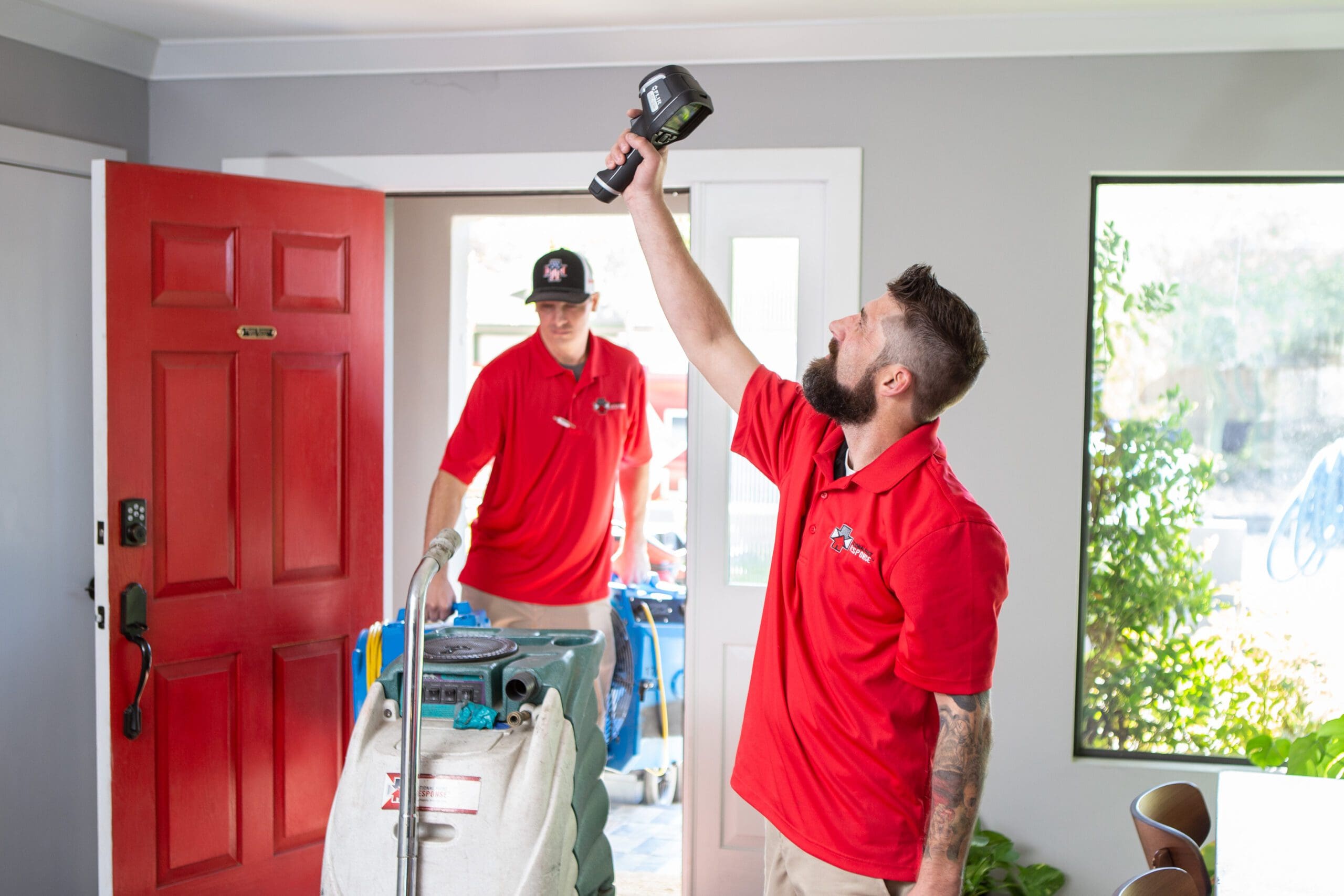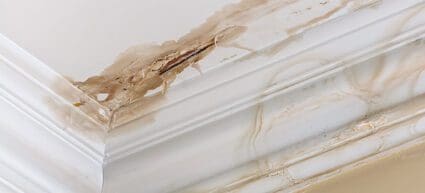Contact Us

How to Handle Ceiling Water Damage
How often have you looked up to notice a ceiling with bulges, peeling paint, or discoloration? In older homes and businesses, these imperfections may seem common. However, these issues are more than unsightly—they point to a potentially serious issue of ceiling water damage.
If you suspect a pipe has burst or a recent storm has caused water to leak through your roof, it’s crucial to address the problem promptly. Ceiling water damage can spread and lead to microbiological growth or structural issues. Early signs include a soft protrusion, stains, or flaking paint on your ceiling. Read on for your next steps…
Can Ceiling Water Damage Be Repaired?
 Ceiling water damage left unattended may cause ceiling materials to deteriorate, jeopardizing the structural integrity of your ceiling, endangering your safety, or fostering the growth of microorganisms. But by taking prompt action, the worst-case scenario can be avoided.
Ceiling water damage left unattended may cause ceiling materials to deteriorate, jeopardizing the structural integrity of your ceiling, endangering your safety, or fostering the growth of microorganisms. But by taking prompt action, the worst-case scenario can be avoided.
Water damage cleanup is best left to the professionals, so it is wise to contact one as soon as you suspect damage. However, there are certain things homeowners may do to reduce secondary damage while they wait for the experts to arrive.
Steps for Repairing a Water-Damaged Ceiling
Here, we walk you through some of the procedures for repairing a water-damaged ceiling:
1. Find And Stop The Source Of The Water
Roof leaks resulting from severe weather, clogged gutters or soffits, dryer vent condensation, and leaky pipes are all possible sources of water damage on ceilings.
The source of the water damage must be identified before any kind of repairs can be made. If you don’t locate and deal with the issue’s root cause, it will continue, and simple repairs can become more complex.
Given how quickly ceiling water damage can spread, the source may be further than where the ceiling is affected. If you notice a wet stain and suspect a roof leak, it could be challenging to pinpoint the precise location where water is entering the structure. A leaking drain or a lack of caulk may also be to blame, even if you are aware that the stain is above a bathroom. In some cases, you might need to remove the drywall to find the source.
Professional ceiling water damage restorers locate the wet areas and determine the root cause using highly specialized gear.
2. Dry the Ceiling
After the initial leak or water source has been located, the next step will be to dry out the entire ceiling. To stop microbial growth from occurring under the drywall all of the affected areas must be dried if there are significant leaks. A portion of the ceiling can be removed to improve airflow, and a fan can then begin drying the damaged area.
While drying the ceiling, take care to protect the floor and any furniture from water drips or falling debris falls.
3. Remove the Damaged Portions
Make sure to remove the damaged portions after drying the affected regions. In some circumstances, the structure’s components should be entirely discarded. In some cases, you’ll need to remove a section of the damaged drywall and replace it with fresh drywall.
On the other hand, if your drywall has stains but is still structurally sound, you might only need to remove the damaged area. Removing drywall is often done with a keyhole saw, but many find this work best left to professionals. If you do decide to undertake it on your own, wear safety equipment whenever cutting or using sharp tools.
If your damage is limited to bulging or peeling, simple scraping may be all that is required to remove affected sections.
4. Ceiling Repair
After the processes of cleanup, drying, and removal, ceiling repair is usually required.
Sandpaper can be used to remove ridges and lumps from any rough surfaces. After allowing these areas to dry, smooth them down once again.
Measure each hole if you are working on larger pieces. Then, with allowances to guarantee an appropriate fit, cut a fresh piece of drywall 2 inches wider and longer than the hole. Later, it can be shrunk to the proper size with a utility knife.
5. Fresh Paint
It’s time to prime and paint your ceiling to complete the project. You can either touch up the repaired areas or, to make the ceiling appear even, repaint the entire thing. As you apply primer and begin painting, keep the area well-ventilated by opening all the windows.
Repair Water Damaged Ceilings Quickly
If left unattended, ceiling water damage can have disastrous effects. This is why knowing how to repair a ceiling from water damage is a critical first step for homeowners and business owners alike.
While the restoration process seems straightforward, it is often best left to a water damage repair company that has the necessary skills, equipment, and experience. A team of restoration experts can help you locate the initial leak source with advanced tools and handle the cleanup, repair, and restoration process with expertise and efficiency, letting you relax and know that the job was done right.
Talk to one of our water damage professionals today to explore your repair and restoration options!
